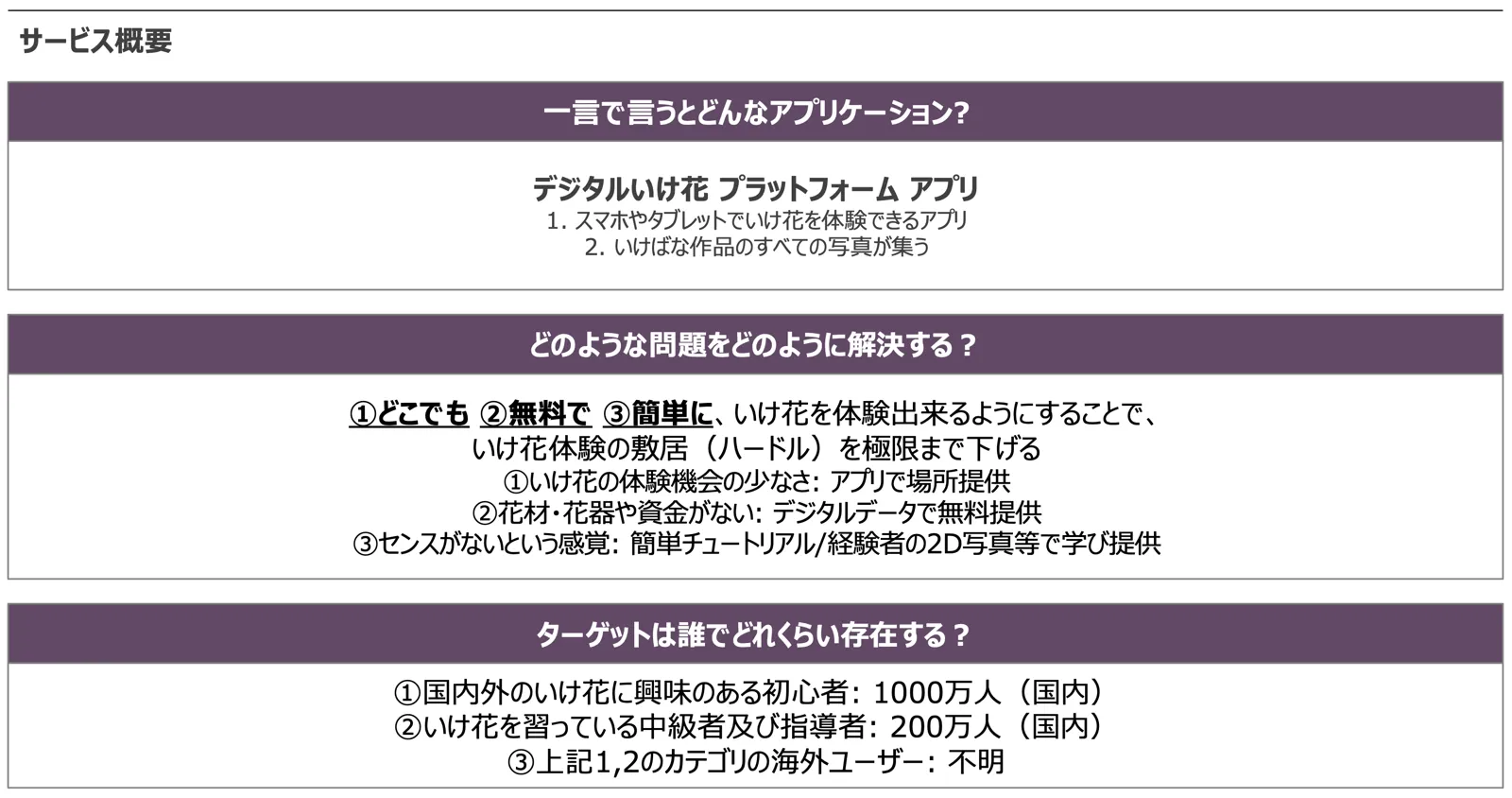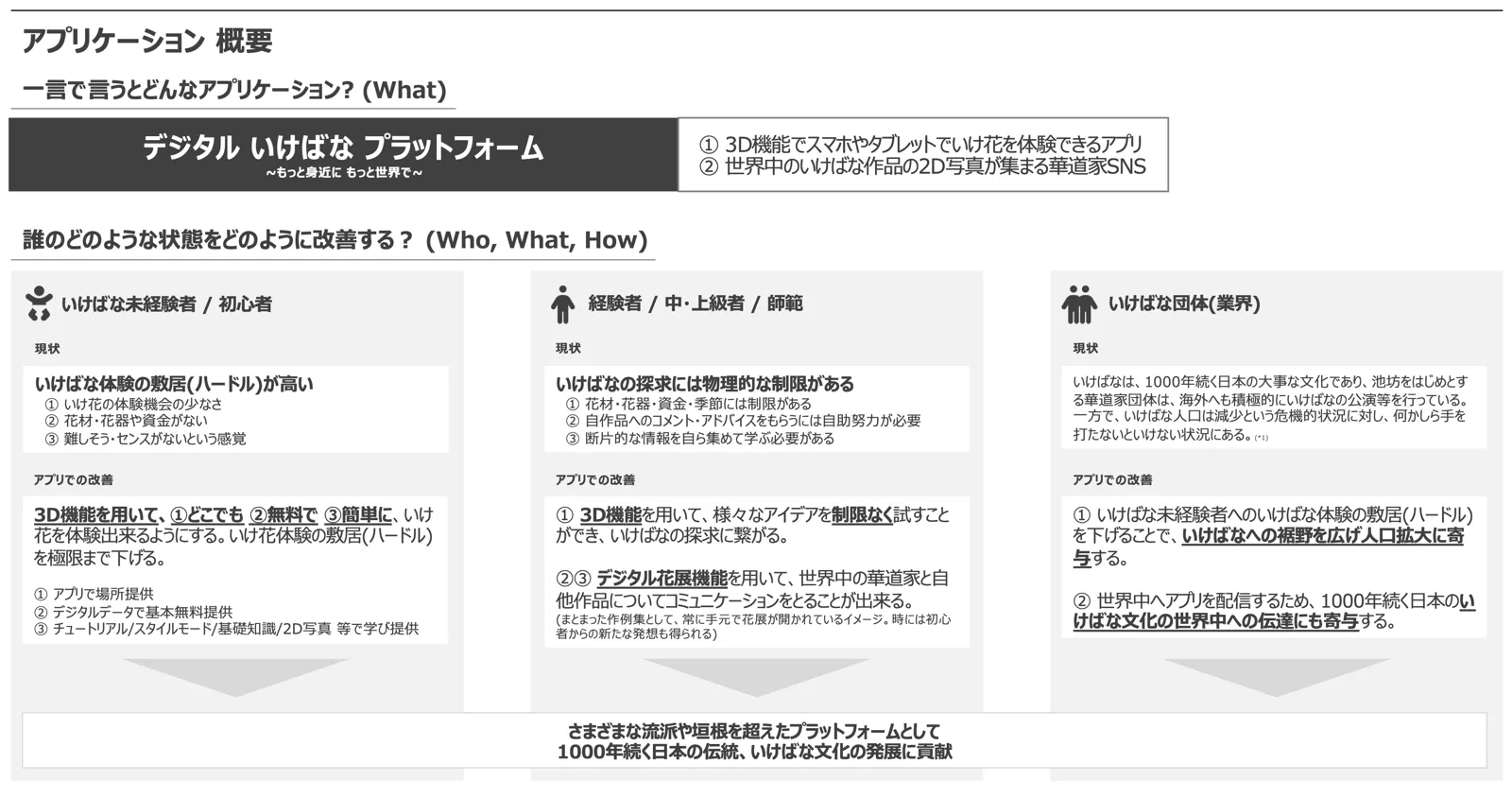Until the concept takes shape
How It Came Down to “Experience Ikebana with Your Smartphone”
After the initial idea came to me, I started wondering, “What kind of service is this, really?”
Based on past service development experience, there are questions I always ask myself during development.
- What kind of service is it, in a single sentence?
- Whose problem does it solve, and how?
- Who is the target audience, where are they, and how many are there?
My initial answers, based on my own thinking, were:
- “An app that lets you experience ikebana using 3D data on your smartphone or tablet.”
- “Lowering the barrier to entry for ikebana for people who have never tried it.”
- Target audience: I didn’t know. I wrote “the whole world.”
Looking back, it was a rough answer, but I tried to articulate it as a starting point. At this stage, I needed words to shape the idea. Even if I revised it later, that was the starting point.
 PowerPoint from that time
PowerPoint from that time
Design Supporting Both Beginners and Experienced Users
My initial assumption was simply that if beginners could casually experience ikebana culture and even a few more people became interested, that would be good enough. However, for an app service to grow sustainably, it needs users to keep coming back.
If the app’s purpose ended for someone just by having them try ikebana once, they wouldn’t keep using it. That would make the app’s long-term growth difficult. So I realized I needed to create an app that not only beginners but also experienced practitioners and current students would want to keep using.
Being a beginner myself, I initially focused on making it “fun and accessible for beginners.” But as I thought more deeply, I began to see its value for experienced practitioners too—as a “place to test ideas” and a “space to practice without using materials.”
Who is this app for? Different user attributes mean different challenges and required features. From that perspective, I designed the current features to match the needs of everyone from complete beginners to experienced practitioners.
Of course, I don’t think the current version is perfect. But I believe it’s best to launch it in this form, gather user feedback, and then gradually refine and improve it step by step.
For those who want to try ikebana, it lowers the barrier to entry. For those already practicing, it becomes a testing ground for new expressions. I thought it would be interesting if I could achieve a good balance of both.
How Digitalization Can Contribute to Japanese Culture
As I developed my ideas, my focus expanded beyond Japan to include the international scene. Even in Japan, people face hurdles like “no nearby classes,” “cost concerns,” and “doubts about their own artistic sense.” But for people overseas, the fundamental issue is that classes often don’t exist at all. In other words, opportunities for hands-on experience are even more limited abroad.
On the other hand, through online research and conversations with my ikebana teacher, I learned about Ikenobo’s overseas performances and the group IKENOBOYS. I discovered how the headmasters and various schools are dedicated to developing and transmitting ikebana culture, and that the overall ikebana population is declining due to factors like Japan’s shrinking and aging population.
Of course, digitizing everything indiscriminately isn’t the answer. The idea is to respect traditional culture as much as possible, understand it correctly, and then, if there are things that can be done digitally, to try them.
From all this, I came to see this not just as an app, but as a tool that could help develop and expand Japan’s traditional culture. My skills as an engineer, perhaps a bit grandly put, might be able to contribute to Japanese culture that has continued for over 1000 years.
It’s not just about finding personal passion; as a Japanese person, if I can contribute to the development of traditional Japanese culture, it could give my own life a deeper meaning. That’s how I’ve come to see it.
Continuously Refining the Concept
Thinking through the app’s UI/UX, actually developing it, getting users to try it and gather feedback – throughout this entire process, the concept undergoes repeated refinement.
This process of constantly improving the concept is tedious, but it forms the app’s framework and foundation. If this part is shaky or weak, the functionality can become weak too. Endlessly writing ideas on scrap paper, erasing them, designing, building, receiving feedback, and rethinking the concept.
Each day brings me a little closer to thinking, “Could this be it?” but simultaneously makes me realize, “No, it’s still not enough,” and start over. It was this cycle. Only after pouring it all into PowerPoint did the big picture gradually come into focus, and it took quite some time before I could finally say, “This is the app’s concept.”
 the concept at the time of the first release
the concept at the time of the first release
